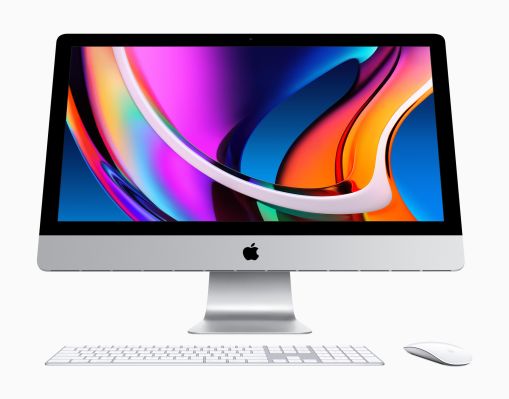Apple sold a lot of Macs last quarter — a record, in fact, for Q3, jumping a full 21%, year over year. Given the state of the world, with most office workers moving to a remote setup, there’s little surprise the company’s desktop and laptops moved at such an impressive clip. For that reason alone, there’s probably no better time to offer a substantial refresh to the company’s perennial favorite all-in-one.
This morning, Apple took the wraps off the latest version of its 27-inch iMac. The changes are, notably, almost exclusively under the hood, but there are a number of key updates as it eyes its longtime bread and butter creative pro clients that it previously courted with the iMac Pro and Mac Pro.
Top-level changes here include the addition of the 10th-gen Comet Lake processors that Intel revealed back in April. The six and eight-core versions of the chips will come as standard configurations, upgradable all the way up to a 10-core i9, which starts to push into the low-end of iMac Pro territory. Per Apple’s numbers, there’s up to a 65% CPU performance increase on-board, particularly noticeable on creative pro apps like Logic and Final Cut Pro.
Graphics, naturally, are getting a boost, as well, at up to 55% faster than previous models, courtesy of the AMD Radeon Pro 5000 series — similar to what’s currently found on the 16-inch version of the MacBook Pro. The RAM is configurable all the way up to a hardy 128GB of DDR4. SSD storage is finally standard across all iMacs, as well. Here the base is 256GB, configurable up to 8TB. The system also now sports the company’s proprietary T2 security chip, as well as an optional 10GB Ethernet connection.
The display is essentially the same as the previous model, though it now features Apple’s True Tone technology for a more natural color balance based on ambient light in the room. There’s also an option for the nano-texture technology found on Apple’s Pro Display XDR, which promises to reduce glare by better scattering light — a nice upgrade for video editors, especially those now working from home with less than ideal lighting situations. Speaking of remote work, the webcam and mic system have been upgraded. The camera is 1080p, coupled with a similar microphone system as the one found in the 16-inch MacBook, featuring two in the system’s “chin” and one in the back.
Contrary to all of the rumors, there’s no redesign here. While it seems entirely plausible — even likely — that a major one is on the way, you’ll have to wait for that. Ditto for the upcoming in-house ARM-based chips. Apple, of course, previously announced that the transition process would take two years to complete — and that there were still Intel Macs in the pipeline. It remains to be seen, however, if the 27-inch iMac will be the last of its kind of that front.
Apple has also noted that it will continue to support Intel Macs for “years to come,” though it’s easy to imagine plenty of folks simply holding off on an upgrade, unless their needs are more dire. And there are probably a number of people in the latter camp, as well, as the reality of working from home doesn’t appear to be ending any time soon (not, for instance, Google’s recent decision to push things back to next July).
The 27-inch still starts at $1,799 and is available starting today. The iMac Pro, meanwhile, now features a 10-core processor (up from 8) as the default configuration, at the same price of $4,999, while the 21.5-inch line (which offers SSDs across the board, as per the above) starts at $1,099.
